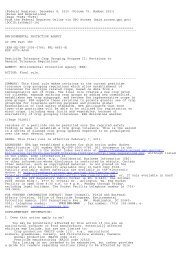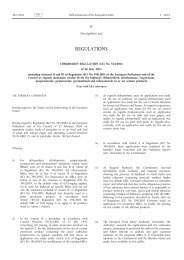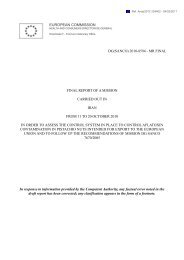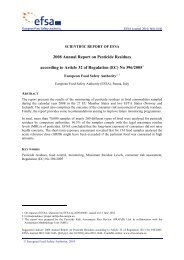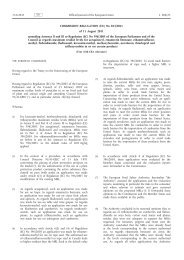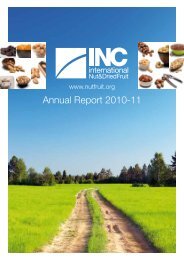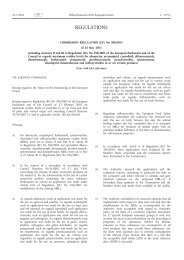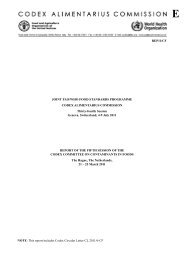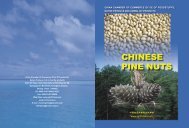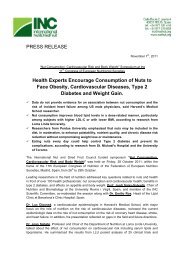final report of a mission carried out in brazil from 15 to 24 march ...
final report of a mission carried out in brazil from 15 to 24 march ...
final report of a mission carried out in brazil from 15 to 24 march ...
Create successful ePaper yourself
Turn your PDF publications into a flip-book with our unique Google optimized e-Paper software.
Article 5 <strong>of</strong> Regulation (EC) No 852/2004.The requirements <strong>of</strong> the section 2.8 on s<strong>to</strong>rage conditions for tree nuts <strong>of</strong> the Codex AlimentariusCode <strong>of</strong> Practice for the prevention and reduction <strong>of</strong> afla<strong>to</strong>x<strong>in</strong> contam<strong>in</strong>ation <strong>in</strong> tree nuts (CAC/RCP59-2005, REV.1-2006) were not always followed <strong>in</strong> the establishments visited by the <strong>mission</strong> team.Traceability is not fully <strong>in</strong> l<strong>in</strong>e with section 33 <strong>of</strong> the Codex Alimentarius Code <strong>of</strong> Practice for theprevention and reduction <strong>of</strong> afla<strong>to</strong>x<strong>in</strong> contam<strong>in</strong>ation <strong>in</strong> tree nuts (CAC/RCP 59-2005). 4F<strong>in</strong>d<strong>in</strong>gs5.4.3 Non-compliant products rejected <strong>in</strong> the EUNormative MAPA Instruction No 13/2004 lays down the procedure <strong>to</strong> follow for non-compliantBrazil nuts rejected and returned by import<strong>in</strong>g countries. Under this procedure, rejected andreturned consignments are subject <strong>to</strong> afla<strong>to</strong>x<strong>in</strong> control by VIGIAGRO (as feed) and ANVISA (asfood) at the po<strong>in</strong>t <strong>of</strong> import prior <strong>to</strong> further process<strong>in</strong>g.In accordance with the above Instruction, rejected and returned Brazil nuts can be imported <strong>in</strong><strong>to</strong>Brazil and used on the domestic market as food when afla<strong>to</strong>x<strong>in</strong> analysis shows levels below 30 ppb,or as feed when afla<strong>to</strong>x<strong>in</strong> analysis shows levels below 50 ppb. For levels above 50 ppb, the Brazilnuts have <strong>to</strong> be destroyed under the supervision <strong>of</strong> VIGIAGRO.The <strong>mission</strong> team was <strong>in</strong>formed that no consignments had so far been returned <strong>to</strong> Brazil, so theabove procedure had never been used <strong>in</strong> practice.ConclusionsThere are national procedures <strong>in</strong> place for handl<strong>in</strong>g Brazil nuts rejected and returned by import<strong>in</strong>gcountries.5.5 METHOD OF SAMPLING FOR BRAZIL NUT CONSIGNMENTSF<strong>in</strong>d<strong>in</strong>gsNormative Instruction No 13/2004 lays down the requirements for sampl<strong>in</strong>g follow<strong>in</strong>g Regulation(EC) No 401/2006.The <strong>mission</strong> team was <strong>in</strong>formed that under the National Residues and Contam<strong>in</strong>ants Control Planfor Plant Products dur<strong>in</strong>g 2009/2010 some 30 samples <strong>of</strong> Brazil nuts would be taken for afla<strong>to</strong>x<strong>in</strong>control <strong>from</strong> April–June onwards. The <strong>mission</strong> team was <strong>in</strong>formed that these samples would betaken only <strong>from</strong> establishments authorised as EU exporters. It was planned <strong>to</strong> extend these controls<strong>to</strong> other Brazil nut processors <strong>in</strong> future.The <strong>mission</strong> team observed a sampl<strong>in</strong>g demonstration on a Brazil nut consignment <strong>of</strong> 26 000 kg(1 300 bags <strong>of</strong> 20 kg each) at one <strong>of</strong> the Brazil nut exporters. The SIPAG <strong>in</strong>spec<strong>to</strong>r <strong>to</strong>ok 100<strong>in</strong>cremental samples <strong>of</strong> 300 g each <strong>from</strong> 100 selected bags <strong>to</strong> produce an aggregate sample <strong>of</strong> 30 kg.The aggregate sample was put <strong>in</strong><strong>to</strong> a bag, which was then packed <strong>in</strong> a cardboard box, sealed andlabelled by the <strong>in</strong>spec<strong>to</strong>r. Under the sampl<strong>in</strong>g procedure, the sampl<strong>in</strong>g and shipment <strong>report</strong>s are thencompleted and the sample is sent for analysis <strong>to</strong> the <strong>of</strong>ficial labora<strong>to</strong>ry — LACQSA/LANAGRO-MG — <strong>in</strong> Belo Horizonte. At the labora<strong>to</strong>ry, the samples are then divided <strong>in</strong><strong>to</strong> three equallabora<strong>to</strong>ry samples before homogenisation.4 In their response <strong>to</strong> the draft <strong>report</strong> the Brazilian Authorities noted that the traceability criteria <strong>in</strong> the NormativeInstruction No 11, <strong>of</strong> 22 March 2010 requires measures <strong>from</strong> the processors which guarantee the traceability withdata <strong>from</strong> the Amazon region where the supplied Brazil nuts orig<strong>in</strong>ates and <strong>to</strong> <strong>in</strong>clude data <strong>of</strong> this supplier.9



